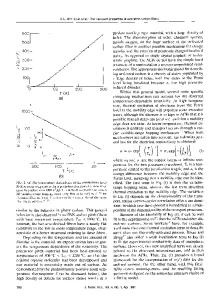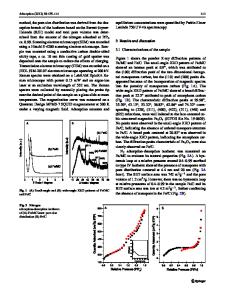Development of activated carbon fibers for removal of organic contaminants
- PDF / 1,311,436 Bytes
- 12 Pages / 595.276 x 790.866 pts Page_size
- 56 Downloads / 392 Views
ORIGINAL PAPER
Development of activated carbon fibers for removal of organic contaminants D. S. S. Alkathiri1 · M. A. Sabri1 · T. H. Ibrahim1 · Y. A. ElSayed2 · F. Jumean2 Received: 5 February 2020 / Revised: 28 April 2020 / Accepted: 9 June 2020 © Islamic Azad University (IAU) 2020
Abstract Chemically and physically activated carbon fibers (ACFs) were produced using PAN (polyacrylonitrile) fibers and their properties were compared with commercial samples. Chemical activation using 3:1 KOH (ww−1) yielded fibers with 2885 m2 g−1 surface area, whereas fibers produced via physical activation with carbon dioxide had an area of only 774 m2 g−1. The surface area of the commercial sample was found to be 1500 m2 g−1. Notably, the total volume of pores, Vt, was 2.39 and 0.633 cm3 g−1 for synthetic (Syn-ACFs) and commercial (C-ACFs). The two fiber types were investigated for p-cresol removal and for treatment of emulsified oil in produced water. At a challenge contaminant concentration of 350 mg L−1 (p-cresol) and 150 mg L−1 (emulsified oil), adsorption studies of p-cresol on Syn-ACFs and C-ACFs at 25 °C gave 91.0 and 71.6% removal efficiencies, respectively. Adsorption of emulsified oil on synthetic ACFs resulted in a removal efficiency of ca. 97%. Adsorption of p-cresol on synthetic and commercial ACFs followed the Langmuir isotherm, with monolayer saturation (qm) values of 500 and 294 mg g−1, respectively. Single cycle regeneration efficiencies by ethanol and n-hexane were 63.8 and 73.6%, respectively. Thermal regeneration at 600 °C was most effective, with an efficiency of 83.9%. Graphic abstract
Editorial responsibility: M. Abbaspour. Extended author information available on the last page of the article
13
Vol.:(0123456789)
International Journal of Environmental Science and Technology
Keywords Activated carbon fibers · Adsorption · Carbonization · Regeneration · p-Cresol · Emulsified oil
Introduction Phenolic compounds are major contaminants in wastewaters generated from pharmaceutical, petrochemical, petroleum, and paper mill industries (Garg and Modi 1999; Hanchang 2009). The presence of phenols or phenolic compounds in small concentrations in public sewage, rivers, sea or surface water can have severe adverse effects on human and marine life. They can also bind to metal ions to form complexes that could be even more carcinogenic than the parent compounds (EPA 1984). The USA environmental protection agency (EPA) requires industries to reduce effluent phenolic concentrations to
Data Loading...











